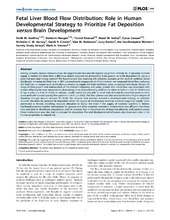| dc.description.abstract | Among primates, human neonates have the largest brains but also the highest proportion of body fat. If placental nutrient supply is limited, the fetus faces a dilemma: should resources be allocated to brain growth, or to fat deposition for use as a potential postnatal energy reserve? We hypothesised that resolving this dilemma operates at the level of umbilical blood distribution entering the fetal liver. In 381 uncomplicated pregnancies in third trimester, we measured blood flow perfusing the fetal liver, or bypassing it via the ductus venosus to supply the brain and heart using ultrasound techniques. Across the range of fetal growth and independent of the mother's adiposity and parity, greater liver blood flow was associated with greater offspring fat mass measured by dual-energy X-ray absorptiometry, both in the infant at birth (r = 0.43, P<0.001) and at age 4 years (r = 0.16, P = 0.02). In contrast, smaller placentas less able to meet fetal demand for essential nutrients were associated with a brain-sparing flow pattern (r = 0.17, p = 0.02). This flow pattern was also associated with a higher degree of shunting through ductus venosus (P = 0.04). We propose that humans evolved a developmental strategy to prioritize nutrient allocation for prenatal fat deposition when the supply of conditionally essential nutrients requiring hepatic inter-conversion is limited, switching resource allocation to favour the brain if the supply of essential nutrients is limited. Facilitated placental transfer mechanisms for glucose and other nutrients evolved in environments less affluent than those now prevalent in developed populations, and we propose that in circumstances of maternal adiposity and nutrient excess these mechanisms now also lead to prenatal fat deposition. Prenatal developmental influences play important roles in the human propensity to deposit fat. | en_US |

